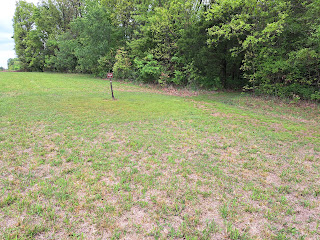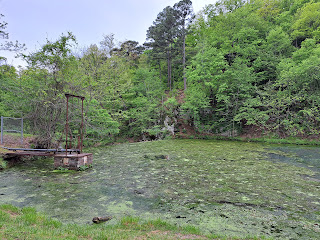Trail: Nester Trail
Hike Location: Trace State Park
Geographic Location: west of Tupelo, MS (34.26021, -88.88655)
Length: 4.7 miles
Difficulty: 4/10 (Moderate)
Dates Hiked: April 2023
Overview: A semiloop on the east side of Old Natchez Trace Lake.
Park Information: https://www.mdwfp.com/parks-destinations/state-parks/trace/
Hike Route Map: https://www.mappedometer.com/?maproute=935531
Photo Highlight:
A small brown metal sign marks the start of the Nester Trail, which immediately heads into the woods. As I mentioned in the introduction, this trail was designed by mountain bikers for mountain bikers, so it has more twists and turns than usual for a hiking trail. Although it is not immediately obvious, you are heading clockwise around the Nester Trail's loop. The trail on the ground can be faint, but there are enough trail markers to keep you on track. The relatively young forest here is dominated by oak, hickory, and sweet gum trees with a few pines mixed in.
Just past 0.5 miles, the park entrance road comes in sight through the trees to the left. Blue diamond mileage markers appear at 0.5 mile intervals. You cross several minor ups and downs, but the trail is designed to keep grades gradual enough to ride a bike comfortably. Moreover, the overall terrain here is pretty flat. I encountered only 1 other user (a hiker) during my hike here.
At 1.5 miles, you cross a gated dirt road. Next you pass through a dense red cedar forest before treading around a sunny meadow area. After more winding through the woods, you reach the east end of the dam that forms Trace Lake at 2.4 miles. You can walk out on the dam to get a good lake view if you wish, but there is a better lake view from the trail coming up in another 0.5 miles.
Now on the west arm of the loop, the trail winds its way north with Trace Lake visible through the trees to the left. 2.9 miles into the hike, you pass through a sunny meadow area that provides the aforementioned nice lake view. The trail continues to wind its way north passing through ravine after ravine and topping ridge after ridge, each one looking similar to the previous one. Wooden bridges get you over most of the creeks in these ravines.
Near 4 miles, you pass through another red cedar thicket. One final hill and a couple of final turns deposit you on the shoulder of the park road at 4.6 miles. Turn right and walk a short distance along the road to return to the parking lot and complete the hike.
Hike Location: Trace State Park
Geographic Location: west of Tupelo, MS (34.26021, -88.88655)
Length: 4.7 miles
Difficulty: 4/10 (Moderate)
Dates Hiked: April 2023
Overview: A semiloop on the east side of Old Natchez Trace Lake.
Park Information: https://www.mdwfp.com/parks-destinations/state-parks/trace/
Hike Route Map: https://www.mappedometer.com/?maproute=935531
Photo Highlight:
Hike Video:
Directions to the trailhead: From the intersection of Gloster Street and Main Street in downtown Tupelo, take Main St. west 10 miles to Faulkner Road and turn right on Faulkner Rd. Drive Faulkner Rd. north 2.1 miles to the state park entrance. Pay the entrance fee, and park in the parking lot to the left (south) of the entrance station.
The hike: Located in northeast Mississippi less than 10 miles off of I-22, Trace State Park protects many acres of succession forest around its namesake Trace Lake. Both the park and the lake are named for the historic Natchez Trace, which runs north-south about 7 miles east of here. Yet the Trace is not this park's only claim to history: Davy Crockett lived on this property for a short time in the 1830's when he worked as a horse trader with the Chickasaw.
The park has some nice amenities that include aquatic recreation on Trace Lake, one of the best disc golf courses in Mississippi, a 76-site developed campground, 5 cabins, 3 cottages, and more than 35 miles of trails. Although most of the trails were built by mountain bikers for mountain bikers, they are also open to hikers, and they see sufficiently little traffic that encountering other users of any type is rare. I chose to hike the Nester Trail described here because it is one of this park's few trails to have a dedicated parking lot. Thus, the trail is easy to find, and it offers a nice woodland journey with occasional views of Trace Lake.
 |
| Nester Trail trailhead |
 |
| 1 mile marker |
 |
| Red cedar thicket |
 |
| Dam that forms Trace Lake |
 |
| View across Trace Lake |








































